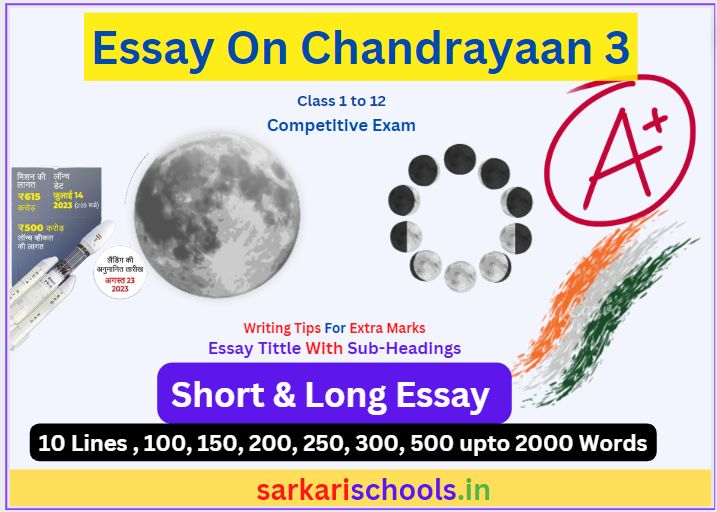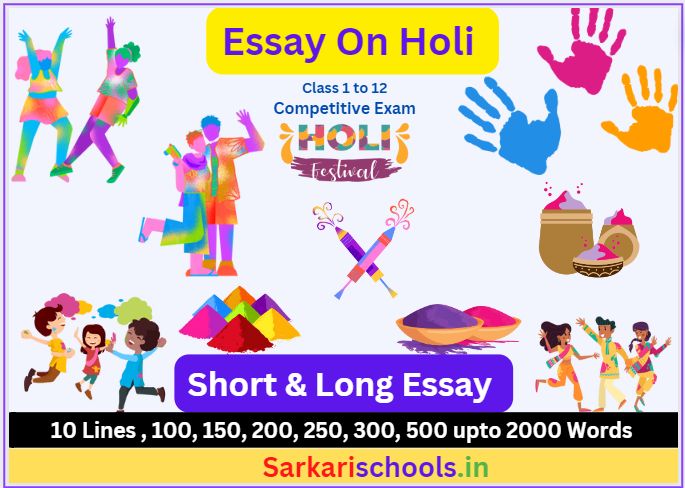Explore the significance, rituals, teachings, and cultural impact of Krishna Janmashtami in this comprehensive Essay on Krishna Janmashtami in English. Learn about the historical origins and enduring relevance of this cherished Hindu festival.
Table of Contents
Short essay on krishna janmashtami in english

100 Words essay on krishna janmashtami in english
Krishna Janmashtami, a Hindu festival, celebrates the birth of Lord Krishna, the eighth avatar of Lord Vishnu. It occurs on the eighth day of the dark fortnight in Bhadrapada, usually in August or September. Lord Krishna is a revered deity, known for his teachings in the Bhagavad Gita and his divine leelas (acts). Devotees fast, pray, and visit temples on this day, seeking his blessings. The Dahi Handi tradition, where human pyramids are formed to break pots of curd, is a highlight. This festival’s cultural impact extends to Indian art, music, and literature, making it a vibrant and spiritually significant celebration in Hindu culture.
Essay on Krishna Janmashtami in English
Long essay on krishna janmashtami in english
I. Introduction
A. Krishna Janmashtami, also known as Janmashtami or Gokulashtami, is one of the most significant and widely celebrated Hindu festivals. It marks the birth of Lord Krishna, an avatar of Lord Vishnu, and is observed with great fervor and devotion by millions of Hindus across the world.
B. Lord Krishna holds a special place in Hinduism due to his multifaceted personality and profound teachings. He is revered as the Supreme God by many, and his life and messages have left an indelible mark on Hindu philosophy, spirituality, and culture.
C. The purpose of this essay is to delve into the rich tapestry of Krishna Janmashtami, exploring its historical background, cultural significance, rituals, and celebrations. We will also discuss the teachings of Lord Krishna and their relevance in contemporary society. By the end of this essay, you will have a comprehensive understanding of this vibrant and spiritually significant festival.
II. Historical and Mythological Background
A. Krishna Janmashtami has its roots in a rich tapestry of history and mythology.
- Historical Origins:
- Krishna Janmashtami commemorates the birth of Lord Krishna, who is believed to have lived approximately 3,000 to 5,000 years ago during the Dvapara Yuga, a significant cosmic age.
- The historical significance lies in the birth of a divine being whose life and teachings would profoundly impact the course of history and spirituality.
B. Lord Krishna, celebrated on this day, holds a special place as the eighth avatar of Lord Vishnu, a fundamental deity in Hinduism.
- Mythological Significance:
- In Hindu mythology, Lord Vishnu takes various avatars to restore cosmic order and protect dharma (righteousness).
- Lord Krishna is revered as the eighth avatar of Vishnu, embodying divinity, wisdom, and compassion.
- His life’s mission, as depicted in sacred texts like the Bhagavad Gita, is to guide humanity towards righteousness and spiritual enlightenment, making him a revered figure in Hinduism.
III. Significance of Krishna Janmashtami
A. Religious Importance:
- Krishna Janmashtami holds paramount religious significance in Hinduism.
- It commemorates the birth of Lord Krishna, who is regarded as an avatar of Lord Vishnu, the Preserver in the Hindu Trinity.
- Devotees observe this day with fasting, prayer, and deep devotion to seek Lord Krishna’s blessings.
- The festival reinforces faith in divine incarnations and reaffirms the belief in the eternal cycle of birth and rebirth (samsara).
B. Cultural Significance:
- Beyond its religious importance, Krishna Janmashtami plays a pivotal role in promoting cultural unity and celebrating diversity.
- Communities from various backgrounds come together to partake in the festivities, fostering a sense of unity among people of different regions and beliefs.
- The festival showcases traditional dances, music, and art forms, reflecting the rich cultural heritage of India.
- It emphasizes the idea of celebrating differences while honoring a common spiritual thread.
C. Preserving Traditional Arts:
- Krishna Janmashtami serves as a platform for preserving and promoting traditional arts.
- Through devotional songs (bhajans) and dance performances (such as the Raas Leela), artistic expressions flourish, ensuring that these age-old traditions are passed down to future generations.
- Artists, musicians, and artisans contribute to the vibrant tapestry of the festival, keeping cultural heritage alive.
- This celebration serves as a reminder of the enduring power of art and its ability to connect people with their cultural roots.
Krishna Janmashtami, therefore, not only holds deep religious significance but also plays a pivotal role in strengthening cultural bonds and preserving traditional arts, making it a multifaceted and cherished festival in the Hindu calendar.
IV. Rituals and Celebrations
A. Fasting, Prayers, and Temple Visits:
- Devotees observe fasting on Krishna Janmashtami as an act of devotion and purification.
- They typically fast from sunrise to the moment of Lord Krishna’s birth, which often occurs at midnight.
- Devotional prayers, chanting of hymns, and reading sacred texts like the Bhagavad Gita are integral parts of the day’s observance.
- Many devotees visit temples dedicated to Lord Krishna, where idols and images are beautifully adorned and worshipped.
B. Dahi Handi Tradition and Its Symbolic Significance:
- The Dahi Handi tradition is a lively and popular aspect of Krishna Janmashtami, especially in regions like Maharashtra and Gujarat.
- In this tradition, a pot of curd (dahi) is suspended at a considerable height, symbolizing the butter that a young Lord Krishna famously stole.
- Enthusiastic groups of young men, known as “Govindas,” form human pyramids to reach and break the pot.
- This tradition represents the playful and mischievous side of Lord Krishna’s childhood and fosters a sense of camaraderie and teamwork among participants.
C. Regional Variations in Celebrating Krishna Janmashtami:
- Celebrations of Krishna Janmashtami vary across different regions of India, adding to the diversity and vibrancy of the festival.
- In northern regions like Mathura and Vrindavan, where Lord Krishna’s life is believed to have unfolded, grand processions, reenactments of his childhood stories, and temple celebrations are common.
- In the southern states, devotees create intricate kolams (rangoli) outside their homes, and special dishes are prepared as offerings.
- In Bengal, the festival is celebrated with dances and singing during ‘Jhulan Utsav,’ where idols of Lord Krishna and Radha are placed on swings.
- In Dwarka, on the western coast, grand processions, and temple visits are integral parts of the celebration.
These regional variations reflect the cultural diversity of India while collectively honoring the same divine figure, Lord Krishna, during Krishna Janmashtami.
V. Teachings of Lord Krishna
A. Key Teachings of Lord Krishna, Especially from the Bhagavad Gita:
- Lord Krishna’s teachings, as elucidated in the Bhagavad Gita, encompass a wide array of profound wisdom.
- In the Bhagavad Gita, Krishna imparts lessons on duty (dharma), righteousness, devotion, and the path to spiritual realization.
- He encourages Arjuna, the warrior prince, to fulfill his duty as a warrior without attachment to the outcome of his actions.
- Krishna expounds the concept of selfless service (karma yoga), devotion (bhakti yoga), and meditation (dhyana yoga) as paths to realizing the divinity within oneself.
- He emphasizes the importance of inner peace and detachment from worldly desires as means to attain spiritual enlightenment.
B. Influence of Lord Krishna’s Teachings on the Festival and Daily Life:
- Lord Krishna’s teachings profoundly influence both the Krishna Janmashtami festival and the daily lives of his devotees.
- Festival Observance:
- During Krishna Janmashtami, the Bhagavad Gita is often recited and contemplated upon, reminding devotees of the importance of righteous action and devotion to God.
- The festival serves as an opportunity for devotees to recommit to the path of dharma and selfless service, aligning their lives with Lord Krishna’s teachings.
- It encourages individuals to reflect on the concept of detachment from material desires, which is central to spiritual growth.
- Daily Life:
- Lord Krishna’s emphasis on duty and devotion influences how devotees conduct themselves in their daily lives.
- Many strive to fulfill their responsibilities with dedication and a sense of duty, mirroring Arjuna’s commitment to his role as a warrior.
- Devotees often engage in acts of charity, selfless service, and meditation as part of their spiritual practice, in line with the teachings of the Bhagavad Gita.
- The principle of detachment from outcomes helps individuals navigate life’s challenges with equanimity, reducing stress and promoting inner peace.
- Festival Observance:
In summary, Lord Krishna’s teachings, particularly from the Bhagavad Gita, serve as a guiding light for both the Krishna Janmashtami festival and the daily lives of devotees, inspiring them to live virtuously and spiritually fulfilling lives.
VI. Festive Foods
A. Special Dishes Prepared During Krishna Janmashtami:
- Krishna Janmashtami is renowned for its delectable and special dishes prepared in homes and temples as offerings to Lord Krishna.
- Makhan Mishri: This sweet dish comprises fresh homemade butter mixed with powdered sugar. It symbolizes Lord Krishna’s love for butter (makkhan) during his childhood.
- Panjiri: Panjiri is a traditional Indian sweet made from whole wheat flour, ghee (clarified butter), sugar, and dry fruits. It is often offered as prasad (sacred food) during the festival.
- Poha: Flattened rice flakes (poha) are cooked with milk, sugar, and spices to create a delightful dish known as ‘Poha Jhanki,’ which is presented to Lord Krishna.
- Kheer: A creamy rice pudding made with milk, sugar, and cardamom, kheer is a popular sweet dish prepared during the festival.
B. Symbolism of Certain Foods in the Celebration:
- The preparation and consumption of these special dishes hold deep symbolic significance:
- Butter (Makhan): Butter represents Lord Krishna’s childhood and his mischievous antics of stealing butter from homes in his village. It symbolizes the innocence and playfulness of Krishna.
- Panjiri: Panjiri’s ingredients, including wheat and ghee, signify the earth’s bounty and nourishment, reflecting Lord Krishna’s role as a provider and sustainer.
- Poha: Poha’s white color signifies purity and devotion, and its preparation mirrors the simplicity of offerings made to Lord Krishna in the past.
- Kheer: The creamy richness of kheer symbolizes the sweetness of devotion and the rewards of a life led in alignment with Lord Krishna’s teachings.
These festive foods not only satisfy the palate but also serve as a reminder of the divine presence of Lord Krishna during Krishna Janmashtami, reinforcing the deep spiritual connection between devotees and their beloved Lord.
VII. Cultural Impact
A. Influence on Indian Art, Music, and Literature:
- Krishna Janmashtami’s celebration has left an indelible mark on various facets of Indian culture, including art, music, and literature.
- It has been a rich source of inspiration for artists, musicians, and writers, contributing to the vibrancy of India’s cultural landscape.
B. Famous Works of Art and Literature Inspired by Lord Krishna:
- Lord Krishna has been a muse for countless artists and authors, resulting in masterpieces that continue to captivate audiences worldwide.
- Music:
- Classical music in India, notably Hindustani and Carnatic traditions, often features compositions dedicated to Lord Krishna. Renowned classical vocalists and instrumentalists have rendered melodious bhajans and kirtans that celebrate his divine presence.
- The iconic “Hare Krishna” mantra, popularized by the International Society for Krishna Consciousness (ISKCON), has gained global recognition and is a testament to the impact of Lord Krishna’s name in music.
- Art:
- Paintings and sculptures depicting Lord Krishna’s various leelas (divine acts) and life events are prevalent in Indian art. The intricate Pichwai paintings of Rajasthan and the exquisite sculptures of Khajuraho and Ellora Caves are notable examples.
- The ‘Krishna Leela’ or ‘Raas Leela’ depictions in Indian art showcase Lord Krishna’s dance with the gopis (cowherd maidens) and symbolize divine love and devotion.
- Literature:
- The Mahabharata, an epic text of ancient India, contains the Bhagavad Gita, a philosophical dialogue between Lord Krishna and Arjuna. This scripture has been translated into numerous languages and remains a timeless guide to life’s challenges.
- Prominent poets like Surdas, Mirabai, and Jayadeva have composed devotional poetry centered around Lord Krishna, expressing profound devotion and love for the deity.
- Contemporary authors continue to draw inspiration from Krishna’s life and teachings, weaving his stories into modern literature.
- Music:
Krishna Janmashtami’s influence on Indian art, music, and literature underscores its enduring cultural significance and the timeless allure of Lord Krishna’s persona. His divine presence continues to inspire creativity and spirituality across generations.
VIII. Conclusion
A. Summarize the Main Points of the Essay:
- Throughout this essay, we’ve explored the multifaceted celebration of Krishna Janmashtami.
- We began with its historical and mythological origins, delving into the birth of Lord Krishna and his significance as an avatar of Lord Vishnu.
- We then discussed the festival’s religious and cultural importance, showcasing how it brings together diverse communities and promotes unity while celebrating differences.
- Rituals and traditions, including fasting, prayers, the Dahi Handi tradition, and regional variations, were explored in detail.
- Lord Krishna’s teachings, especially from the Bhagavad Gita, were examined for their influence on both the festival and daily life.
- The essay also highlighted the delightful festive foods and their symbolism.
- Lastly, we explored Krishna Janmashtami’s profound cultural impact on Indian art, music, and literature.
B. Emphasize the Enduring Relevance:
- Krishna Janmashtami’s enduring relevance in Hindu culture and beyond is evident in its continued celebration with unwavering devotion.
- It serves as a timeless reminder of the divine’s intervention in human affairs and the importance of righteousness and spirituality in one’s life.
- In an increasingly diverse and interconnected world, this festival showcases the power of unity and cultural preservation.
C. Reflect on the Festival’s Message:
- Krishna Janmashtami carries a message of devotion, righteousness, and unity.
- Devotion to Lord Krishna, as exemplified in the festival’s rituals, reminds us of the importance of unwavering faith in our spiritual journeys.
- The emphasis on righteousness, mirrored in Lord Krishna’s teachings, encourages us to act with integrity and selflessness in our daily lives.
- The festival’s celebration of unity and diversity underscores the beauty of coming together in shared devotion while respecting and honoring individual traditions and beliefs.
In conclusion, Krishna Janmashtami is not just a day of celebration; it is a profound spiritual journey that transcends time and boundaries. It continues to inspire countless hearts with its message of devotion, righteousness, and unity, making it an indispensable part of Hindu culture and a source of spiritual enlightenment for people worldwide.
Essay on Krishna Janmashtami in English
Extra Tips 4 Extra Marks :
Practice Essay Writing Online
Essay on Krishna Janmashtami in English
Essay on Krishna Janmashtami in English
Essay on Krishna Janmashtami in English Essay on Krishna Janmashtami in English Essay on Krishna Janmashtami in English Essay on Krishna Janmashtami in English Essay on Krishna Janmashtami in English Essay on Krishna Janmashtami in English





